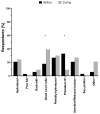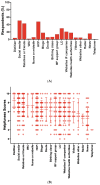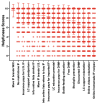Cross-Sectional Analysis of Infant Diet, Outcomes, Consumer Behavior and Parental Perspectives to Optimize Infant Feeding in Response to the 2022 U.S. Infant Formula Shortage
- PMID: 38474876
- PMCID: PMC10934383
- DOI: 10.3390/nu16050748
Cross-Sectional Analysis of Infant Diet, Outcomes, Consumer Behavior and Parental Perspectives to Optimize Infant Feeding in Response to the 2022 U.S. Infant Formula Shortage
Abstract
In May of 2022, millions of U.S. parents encountered uncertainty in safely feeding their infants due to the infant formula shortage.
Methods: An anonymous, electronic, cross-sectional, retrospective survey was used.
Results: U.S. parents (n = 178) whose infants were ~10 weeks old during the shortage completed the survey. Of parents, 81% switched formulas during the shortage, 87% switched because they could not find the formula they typically used, 34% switched 3-5 times, 29% of parents visited ≥4 stores/24 h and 26% of parents traveled >20 miles/24 h to purchase formula. Use of infant formula increased (p < 0.01); in infants requiring specialty formula, use of intact cow's milk formula increased (p < 0.05) and use of premature infant formulas decreased (p < 0.05). Infants relying on specialty formulas experienced at least one undesirable outcome compared with non-specialty users. Parents used social media, relatives/friends and healthcare providers for support during the shortage, but their helpfulness scores were suboptimal. Parents reported the need for greater infant formula availability, free prenatal lactation education and postpartum lactation support.
Conclusions: Government, regulatory and healthcare policy oversight are needed to protect the infant feeding system, including more commercially available products, access to banked donor milk and lactation support.
Keywords: breastfeeding; consumer behavior; equity; feeding practices; food security; government and regulatory policies; health; infant formula shortage; lactation; pediatrics.
Conflict of interest statement
J.T.S. received a gift from Bobbie to support this project. Bobbie was not involved in analyzing the data generated from this or drafting this manuscript. D.M.D. and A.F.P. are medical consultants to Bobbie Labs, the research arm of Bobbie Infant Formula (U.S.).
Figures








Similar articles
-
Infant feeding practices and parental perceptions during the 2022 United States infant formula shortage crisis.BMC Pediatr. 2023 Jun 24;23(1):320. doi: 10.1186/s12887-023-04132-9. BMC Pediatr. 2023. PMID: 37355589 Free PMC article.
-
Physicians advice, parental practice and adherence to doctor's advice: an original survey on infant feeding.BMC Pediatr. 2019 Sep 4;19(1):313. doi: 10.1186/s12887-019-1697-y. BMC Pediatr. 2019. PMID: 31484507 Free PMC article.
-
Comparison of a partially hydrolyzed infant formula with two extensively hydrolyzed formulas for allergy prevention: a prospective, randomized study.Pediatr Allergy Immunol. 2000 Aug;11(3):149-61. doi: 10.1034/j.1399-3038.2000.00081.x. Pediatr Allergy Immunol. 2000. PMID: 10981524 Clinical Trial.
-
Economy in the feeding of infants.Pediatr Clin North Am. 1977 Feb;24(1):71-84. doi: 10.1016/s0031-3955(16)33388-0. Pediatr Clin North Am. 1977. PMID: 322067 Review.
-
Consensus statement on diagnosis, treatment and follow-up of cow's milk protein allergy among infants and children in Turkey.Turk J Pediatr. 2016;58(1):1-11. doi: 10.24953/turkjped.2016.01.001. Turk J Pediatr. 2016. PMID: 27922230
References
-
- US Food and Drug Administration FDA Investigation of Cronobacter Infections: Powdered Infant Formula (February 2022) [(accessed on 15 October 2022)]; Available online: https://www.fda.gov/food/outbreaks-foodborne-illness/fda-investigation-c....
-
- Naylor L. The monstrosity of the corporate control of food shortages: The geopolitics of the 2022 infant feeding crisis in the United States. Geoforum. 2022;137:146–150. doi: 10.1016/j.geoforum.2022.09.019. - DOI
-
- Paris M. One in Five US States is 90% Out of Baby Formula. Bloomberg; New York, NY, USA: 2022.

